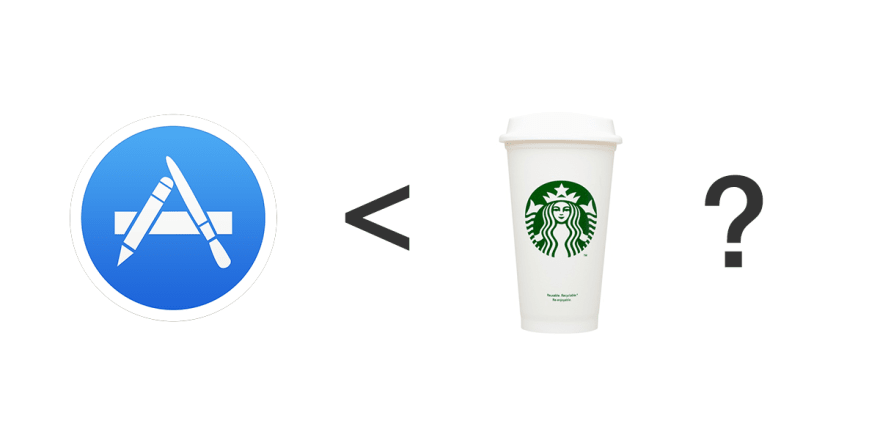Last week, popular writing app Ulysses announced that it would be moving from one-time purchase pricing to a subscription based model. This has all but confirmed a belief that I have long suspected: subscription is the only way to survive as a software company.
Consider the nonsensical way software is currently done: developers spend endless hours researching, developing, fixing, and providing support for software, the hardest of which is probably the last of that array of responsibilities. In return, customers are accustomed to paying discount, wholesale prices of anywhere from 99 cents to $4.99 one time.
One time. For all of eternity.
Since we all love the infamous “this app is cheaper than a cup of coffee — buy now! analogy, consider if Starbucks customers visited the store only once every 10 years to buy a single cup of coffee. How soon do you imagine they’d go out of business?
Repeat business. That’s the American way. I remember some decades ago being overseas and telling some friends that in America, you can return something if you don’t like it. They were shocked. It sounded like heaven. Where they were, once you bought something, it was final.
But this is hardly a case of companies trying to be Good Guy Greg. Why do you think companies pretend to love their customers so much? Why do they offer great customer service, wholesome return policies, and an amazing shopping experience?
All so you come back.
Because if you only came once, they’d be done for.
The 21st century is represented almost more than anything by our awkwardness with how we value digital goods. Infinitely reproducible, we struggle with attributing real value to software. “You wouldn’t download a car, jokes anti-piracy memes. But when will we finally learn that the digital realm is real, if not realer, than the physical? And while customers reap the treasures and loot software for ridiculously low prices, indie software developers and firms are left struggling to make sail.
Repeat business is the name of the game. Whether that’s through paid upgrades or subscription pricing, customers need to come back in order for a software company to survive. The economics of providing endless labor for a ridiculously low-priced one-time purchase simply does not make sense. Microsoft has learned it. Adobe has learned it. And now, indie software developers are finally learning it too.
My advice to developers creating a software company? Aim for repeat business if you wish to survive. Don’t do the Apple deal. Value your work and time.
And for software customers who read this and are horrified by the thought of spending five bucks every month for every app they use: welcome to the future. Welcome to the way this was always going to play out; the only way it could have played out.
I’m proud to say that we do subscription pricing at Standard Notes, an encrypted notes app. This has given us a real shot at surviving. I could not imagine how it would have turned out had we decided to do one-time pricing from the start. I don’t think we’d be here today if we had.







Oldest comments (13)
It depends on the value proposition whether a produce should be charged by subscription or a one-time fee. There are lot of software products that just don't justify an on-going fee. Games are perhaps the biggest one, since they are mainly a short-lived experience.
But there are several development products like this as well. A lot of small things, like individual NodeJS or Python libraries, could unlikely justify an on-going cost (not that a lot of those are for pay). The regular payment would be too small to justify. Sometimes things are just worth $5 for the lifetime of the module. Trying to get somebody to pay $1/month is both too expensive and not worth the overhead.
I'm also a bit concerned about the need to have constantly updated software. Not all things are online, nor are they subject to security concerns. Something like Photoshop for example works very well as a versioned thing. If you have a version that works for you, great, there is no need to update. By having a subscription you are inevitably forced onto an update wagon as well.
Not every software needs to be a service. The "Standard Notes" app you make is a service, and requires resources for continuous operation. I don't need the newest fanciest updates for a text editor, or image manipulating software.
Their prices always ranged from hundreds to thousands of $, those are not ridiculously low-priced one-time purchases.
"Only" is a bit strong - in fact, I'd say "only" and "never" are often pretty reliable flags that the speaker is overlooking something.
I agree that subscription is a viable model for some projects; my company is going to use it for one of our games. However, there are very successful products that don't follow that model.
For example, look at Minecraft. You pay once, and play forever. Yet, it is in the running to become the most profitable and popular computer game in history. They continue to make money from it. How? Users buy the game for different platforms (PC, mobile, XBox), build awesome things, and in turn encourage other people to purchase the game. New users continue to age into the game, so there continues to be a demand. Yes, they also make money through an add-on subscription service, Realms, but Minecraft itself is pay-once-play-forever. Arguably, that is why they succeeded. The adoption would be much lower if the core game were subscription-only.
In a similar way, the subscription model is actually harmful to consumers in some cases, and in turn harms the product. As Microsoft Office switches to a subscription-only service, people have begun to migrate away to options they can afford: WPS (Kingsoft), Google Docs, and LibreOffice continue to take away huge chunks of Microsoft Office's user base. The subscription model is actively harming Office.
When a product is vital to someone's career - say, products from Adobe, Autodesk, or Intuit (or, again, Microsoft Office) - then a subscription model is viewed as a racket by many disgruntled users. Many people are dependent upon Photoshop, 3DSMax, QuickBooks, AutoCAD, and so on. By being forced to pay every month just to have what they need to work, the subscription models mentally translates to paying a mob syndicate for the right to work. This, in turn, fuels hatred for the company, which encourages other companies and entities to create alternatives that aren't subscription-based (possibly even open source).
Thus, in some cases, the subscription model isn't sustainable. Eventually Adobe, Autodesk, and Intuit will lose their place in the world, the same as many industry-standard monopolies of yesteryear. People will increasingly hesitate to buy into new products from these companies, because they know they're just being taken advantage of. By destroying the trust that users once had in them, these companies will be unable to pivot, and will die off. It's a pattern not exclusive to software: history is rife with examples of this.
In short, consider the effects of your model on your customers. Will subscription-based make sense for them? Will they actually come back, or feel jilted? Subscription-based can work in many cases, but others are reliably sustained by other means: paid support (Red Hat), add-ons and extensions, expanding the user base (Mojang), or a broad range of products (Rovio).
Very intereting point you make here! Even though Adobe CS subscription pricing is cheaper over the years than the old paid upgrades, now people are forced into it and cannot take the way of "save money for a while, buy once, update never." It's less choice, not just more awesomenes.
Adobe's subscription might be cheaper than upgrading every time was, but is it also cheaper if you decide "hey, I can't afford to upgrade right now, I'll get the update next time with more features"? Because a lot of people were doing exactly this. And what if one update requires a new version of Mac OS? Which in turn requires newer hardware, or is incompatible with another piece of software?
My point is: with a subscription, you take away customers' freedom to choose what's best - they're in on Adobe's terms, or they're out. And I guess for a lot of creators this means they'll be out - or, you know, running CS6.
I totally agree.
This should open opportunities for other developers to fill a hole. Like Sketch for Mac is replacing Photoshop for UI design. Although it may be hard for full time designers to not have access to Adobe tools, just like you still cannot get past Microsoft Word in lots of jobs. (Office became subscription-only, too. Hmm!)
Legally, Adobe and The Soulmen have all rights to be picky about customers. If they prefer steady income over more customers, so be it. But then the ethics get twisted: from serving people to making profit. No point in denying that. But that's usually not how companies frame it :)
The problem is that, to use Adobe and Autodesk products, you bind yourself to proprietary formats. If you stop paying for, say, Illustrator or AutoCAD, you lose part or all of your work, since no other program supports the format 100%.
This is a problem for us customers/users who are now locked in. But it's not a morally bad move per se. It's shady. You know what they are up to. But it's hard to make an argument for opening up the format to the public when it's part of their business model.
Well, the fact that it's used to keep users in place is, inherently, dishonest and unethical. Short-term profitable, perhaps, but such shady practices always ultimately end badly for the company. ;) (Literally just wrote an article about it.)
I'd like to think so, for the sake of ultimate justice and all 👍 :) What's the URL of your article?
Here you go: dev.to/codemouse92/the-other-ranso...
I personally like the subscription mode because it allows me to access software that I otherwise wouldn't be able to afford. It's much easier for me to pay a monthly fee for something I use and stop when I don't need it anymore rather than save up a bunch of money to buy a version of the software that will be out of date in a year or two.
Hey Mo, I'm building an Electron app and finding difficult to design/setup a subscription flow. Can you please explain to me how subscription pricing at Standard Notes works? (Like what tools/resources you use.) Also, are you using Quill.js for the editor?